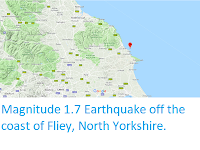The British Geological Survey recorded
a Magnitude 3.3 Earthquake at a depth of 10 km about 40 km of the coat of Norfolk, England, slightly
after 6.30 am British Summertime (slightly after 5.30 am GMT) on Thursday 23 April 2020.
There are no reports of any damage or injuries associated with this
event, though it may have been felt on parts of the English easr coast.
The approximate location of the 23 April 2020 North Sea Earthquake. Google Maps.
Earthquakes become more common as you travel north and west in Great
Britain, with the west coast of Scotland being the most quake-prone part
of the island and the northwest of Wales being more prone to quakes
than the rest of Wales or most of England.
The precise cause of Earthquakes in and around the UK can be hard to determine; the
country is not close to any obvious single cause of such activity such
as a plate margin, but is subject to tectonic pressures from several
different sources, with most quakes probably being the result of the
interplay between these forces.
Britain is being pushed to the east by the expansion of the Atlantic
Ocean and to the north by the impact of Africa into Europe from the
south. It is also affected by lesser areas of tectonic spreading beneath
the eastern North Sea, Rhine Valley and Bay of Biscay, notably the
Lower Rhine Graben, an area of tectonic expansion beneath the Rhine
Valley, and the North Sea Central Graben, the
Terschelling Graben and The Horn Graben, the similar areas of expansion
beneath the North Sea. These areas do not generate new ocean floor or
expand on the same scale as the Mid Atlantic Ridge or similar
structures, but they do exert pressure on the rocks around the North Sea
Basin, and can lead to Earthquakes in any of the countries surrounding
the Basin.
Map showing the location of the North Sea Central and Terschelling Grabens. Numbered locations are oil rigs. Abbink et al. (2001).
Finally the country is subject to glacial rebound; until about 10 000 years ago much of the north of the country was covered by a thick layer of glacial ice (this is believed to have been thickest on the west coast of Scotland), pushing the rocks of the British lithosphere down into the underlying mantle. This ice is now gone, and the rocks are springing (slowly) back into their original position, causing the occasional Earthquake in the process.
(Top) Simplified diagram showing principle of glacial rebound. Wikipedia.
(Bottom) Map showing the rate of glacial rebound in various parts of
the UK. Note that some parts of England and Wales show negative values,
these areas are being pushed down slightly by uplift in Scotland, as the
entire landmass is quite rigid and acts a bit like a see-saw. Climate North East.
Witness accounts of Earthquakes can help geologists to understand these events, and the structures that cause them. If you felt this quake, or were in the area but did not (which is also useful information) then you can report it to the British Geological Survey here.
See also...
Follow Sciency Thoughts on Facebook.










